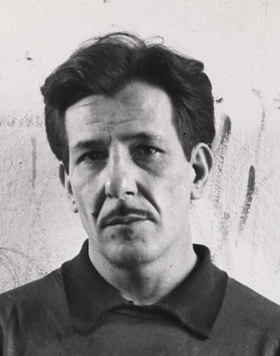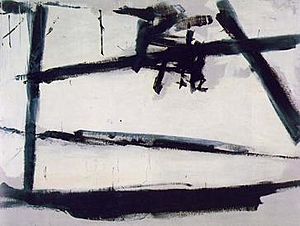Franz Kline facts for kids
Quick facts for kids
Franz Kline
|
|
|---|---|

Kline, c. 1960
|
|
| Born |
Franz Kline
May 23, 1910 Wilkes-Barre, Pennsylvania, U.S.
|
| Died | May 13, 1962 (aged 51) New York City, NY, U.S.
|
| Education | Boston University |
| Known for | Abstract painting |
| Movement | Abstract expressionism, action painting |

Franz Kline (born May 23, 1910 – died May 13, 1962) was an American painter. He was a key artist in the Abstract Expressionist movement. This was a style of art popular in the 1940s and 1950s.
Kline was part of a group called the New York School. This group included other famous artists like Jackson Pollock and Willem de Kooning. They were known for their exciting style called action painting. Kline's art was special and is still admired today.
Contents
Franz Kline's Life Story
Kline was born in Wilkes-Barre, Pennsylvania. This was a small town in a coal mining area. When he was young, he moved to Lehighton, Pennsylvania. He finished high school there.
Later, his mother sent him to Girard College in Philadelphia. This was a school for boys whose fathers had passed away. After high school, Kline studied art at Boston University from 1931 to 1935. He then spent a year in London, England, at the Heatherley School of Fine Art. In England, he met Elizabeth V. Parsons, a ballet dancer. They returned to the United States together in 1938.
Starting His Art Career
When Kline came back to the U.S., he worked as a designer for a department store. He moved to New York City in 1939. There, he worked for a scenic designer, someone who creates sets for plays. During this time, Kline developed his unique art style. He soon became known as an important artist.
He also taught art at places like Black Mountain College in North Carolina. He taught at the Pratt Institute in Brooklyn too. From 1956 to 1962, he spent his summers painting in Provincetown. Franz Kline passed away in New York City in 1962. He was almost 52 years old.
How His Art Changed
Early Paintings
Franz Kline's art training focused on traditional drawing and illustrating. In the late 1930s and early 1940s, he painted real-life scenes. He created landscapes, city views, and portraits. He also painted murals, which are large wall paintings.
One of his first unique works was a mural series called Hot Jazz. He painted this for a tavern in Greenwich Village in 1940. These paintings showed his interest in breaking down shapes into quick, simple brushstrokes.
His personal style became more and more abstract. Many of his figures were based on trains, landscapes, and big machines. These came from his hometown, which was a coal-mining area. Sometimes, you can only tell what his paintings are about because of their titles. This is because they don't always look like the actual objects.
As he was influenced by the art scene in New York, Kline moved further into abstract art. He stopped painting things that looked exactly like real life. From the late 1940s, he began to turn his subjects into lines and shapes. These fit together like the works of Cubism from that time.
In 1946, a group in Lehighton, Pennsylvania, asked Kline to paint a large picture. It showed the town where he went to high school. This mural, called Lehighton, is now on display at the Allentown Art Museum.
Later Abstract Work
Many people believe Kline's famous style came from a suggestion by his friend, Willem de Kooning. In 1948, de Kooning supposedly told Kline to project a small drawing onto his studio wall. Kline described seeing a small drawing of a rocking chair. When it was projected, it became huge. The black lines were so big they no longer looked like a chair. They became shapes on their own.
After this, Kline started making large, abstract artworks. He began to develop his own style of Abstract Expressionism. Over the next two years, his brushstrokes became completely abstract. They were flowing and full of energy.
It was also around this time that Kline started painting only in black and white. He said that he painted the white just as much as the black. He felt the white was just as important. His use of black and white was similar to paintings by de Kooning and Pollock. Some people also saw connections to Japanese calligraphy in his black and white paintings. However, Kline later said there was no direct link.
First Solo Show
Kline had his first solo art show in 1950. It took place at the Egan Gallery in New York City. The show featured eleven abstract paintings. Color was rarely used in these works. They mostly showed Kline's unique style of black on white.
Because of his strong style, Kline was called the "black and white artist." This name stayed with him. Sometimes, he felt limited by it. This first show was a very important moment for Kline. It marked the beginning of his main invention as an abstract artist. By age forty, Kline had found and mastered his personal style.
Return to Color
In the late 1950s, Kline began to use more complex shading in his paintings. He started adding colorful touches to his black and white works in 1958. This exploration of color was still developing when he passed away in 1962.
Important Exhibitions
Kline had his first big show at the Charles Egan Gallery in 1950. He also took part in the 9th Street Art Exhibition in 1951. In 1958, his work was part of a major exhibition called "The New American Painting." This show traveled to eight cities in Europe.
In the years before he died, his art was shown in many international exhibitions. These included the Venice Biennale and Documenta in Germany. His work was also featured in the São Paulo Biennial and the Whitney Annuals and Biennials.
After his death, many museums held special shows of his art. These included the Whitney Museum of American Art in New York and the Phillips Collection in Washington, D.C.
Where to See His Art
You can find Franz Kline's paintings in many public art collections. Some of these include:
- Governor Nelson A. Rockefeller Empire State Plaza Art Collection (Albany, NY)
- Metropolitan Museum of Art (New York City)
- Museum of Contemporary Art (Los Angeles)
- Museum of Modern Art (New York City)
- Tate Modern (London)
- Whitney Museum of American Art (New York City)
Images for kids
See also
 In Spanish: Franz Kline para niños
In Spanish: Franz Kline para niños
- New York School
- Action painting
- Abstract expressionism


